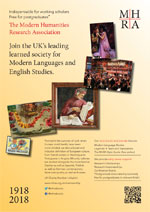MHRA Style Citation Demonstration
Click cover to enlarge | According to the MHRA Style Guide, this item should be cited in a bibliography as follows: Bassnett, Susan, ‘Crossing Textual Boundaries: Why Translation Matters’, in The MHRA Centenary Lectures, ed. by Graham Nelson (MHRA, 2020), doi:10.59860/cl.c7c505c This is how standard MHRA style would look. Some of its book series (notably Legenda) allow an alternative citation system called 'author-date', but please talk to your editor before using it. (To see the demonstration for author-date, follow this link.) Let's take this bibliography entry one step at a time: Step 1. We start with the name(s) of the author(s) of the article, inverting the first name into the form 'Forename, Surname'. Bassnett, Susan Step 2. This is regular MHRA style, so the name's followed by a comma. Bassnett, Susan, Step 3. Now we add the title, in single inverted commas. Any single quotation marks already in the title must be converted to doubles. Bassnett, Susan, ‘Crossing Textual Boundaries: Why Translation Matters’ Step 4. We have to say where this comes from, so: Bassnett, Susan, ‘Crossing Textual Boundaries: Why Translation Matters’, in Step 5. Next we identify where the article is to be found, using italics, not quotation marks, for the volume title. Bassnett, Susan, ‘Crossing Textual Boundaries: Why Translation Matters’, in The MHRA Centenary Lectures Step 6. After the title come any editors or translators. It's 'ed. by', not 'ed by', because although 'ed.' abbreviates 'edited', we regard the 'd' as the second letter of 'edited', not the last: so the abbreviation doesn't contain the last letter, and thus must have a full stop '.' Bassnett, Susan, ‘Crossing Textual Boundaries: Why Translation Matters’, in The MHRA Centenary Lectures, ed. by Graham Nelson Step 7. Since this is a book, not a journal issue, we have to identify its source, in round brackets. Until 2024, MHRA style required a place of publication - for example, New York or Oxford. This is no longer given except in special circumstances. Bassnett, Susan, ‘Crossing Textual Boundaries: Why Translation Matters’, in The MHRA Centenary Lectures, ed. by Graham Nelson ( Step 8. Now a colon, a space, and the publisher's name. Abbreviating to 'MHRA' is fine here. Bassnett, Susan, ‘Crossing Textual Boundaries: Why Translation Matters’, in The MHRA Centenary Lectures, ed. by Graham Nelson (MHRA Step 9. Then the year of first publication, and we're done with the bracketed part. Bassnett, Susan, ‘Crossing Textual Boundaries: Why Translation Matters’, in The MHRA Centenary Lectures, ed. by Graham Nelson (MHRA, 2020) Step 10. This contribution has a DOI, so the Fourth Edition Guide (2024) requires us to quote it, like so. Bassnett, Susan, ‘Crossing Textual Boundaries: Why Translation Matters’, in The MHRA Centenary Lectures, ed. by Graham Nelson (MHRA, 2020), doi:10.59860/cl.c7c505c And that's the finished bibliography entry. Note that there's no final full stop. So how about citations in footnotes or endnotes? In standard MHRA style, the first time the work is cited in a note, it should be cited in full. This looks very like a Bibliography entry, but:
Suppose we want to cite a passage on pages 24 to 27: 34 See Susan Bassnett, ‘Crossing Textual Boundaries: Why Translation Matters’, in The MHRA Centenary Lectures, ed. by Graham Nelson (MHRA, 2020), doi:10.59860/cl.c7c505c, pp. 24-27. But in any subsequent notes, a heavily abbreviated form is used: 37 Compare Bassnett, p. 17. |
